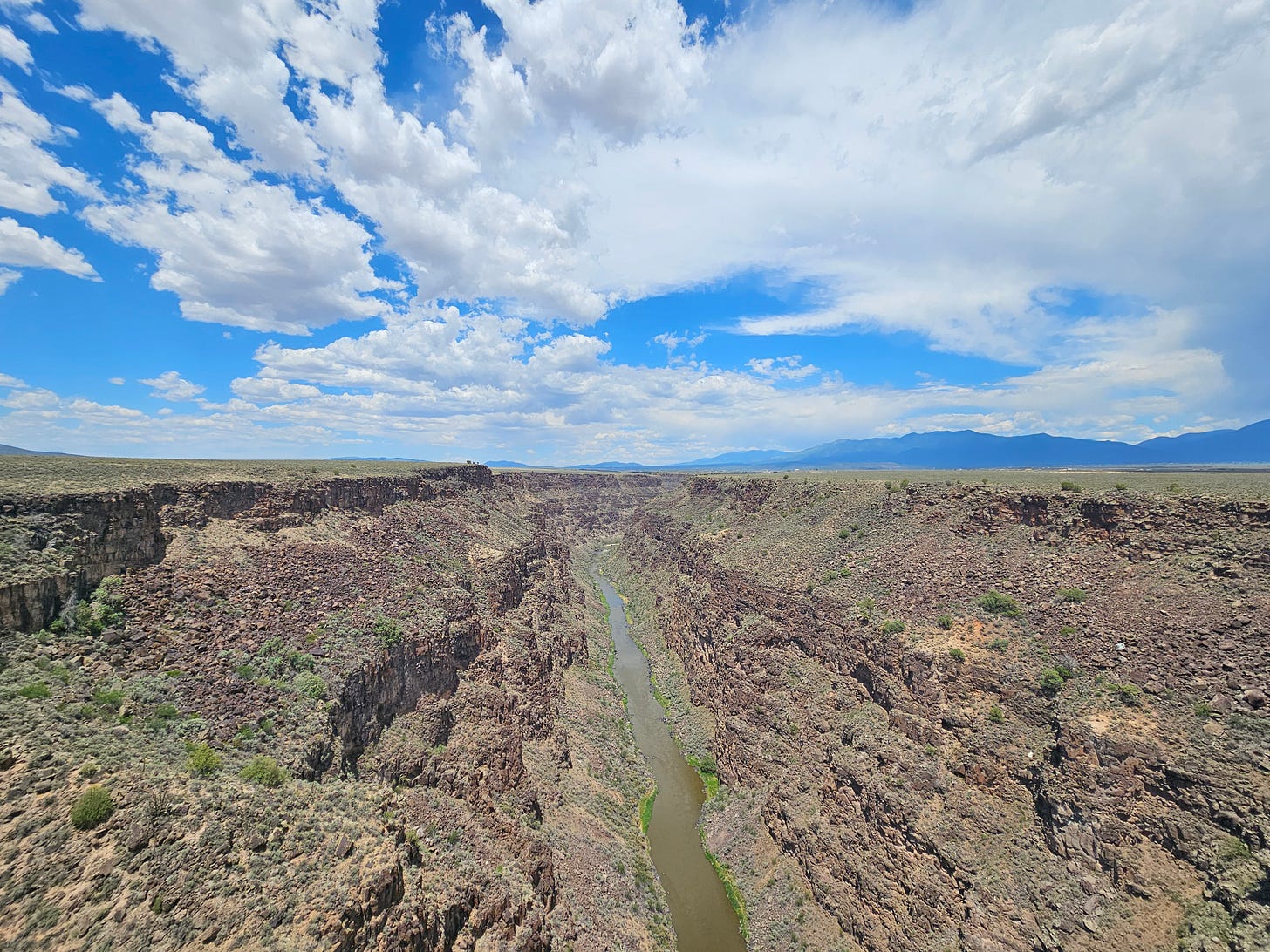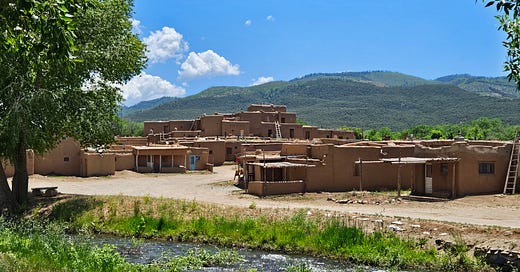This is one of an occasional series on travel through the lens of water. Others include Swim, Bike and Run in the Coachella Valley, and The Desert is All About Water in Tucson.
We recently returned from a trip to Santa Fe and Taos Pueblo in Northern New Mexico. I was, of course, curious about the impact of water on settlement in the area.
gave me a rabbit hole to go down with a Postcard about the Acequias of New Mexico. I dove in! I found some great information in an article from the wonderful New Mexico Museum of Art on History: The Politics of Water, which told me that:New Mexico has the longest continuously traceable history of human water use in the United States.
[T]he organized manipulation of water resources in New Mexico spans back to at least 800 A.D. and the run-off collection systems of the Ancestral Pueblo people of the Four Corners region.
The upper Rio Grande valley is where the Rocky Mountains transition to the basin and range geography typical of the southwest, with valleys filled with layers of silt and alluvial fans. Settlements tend to be along the line where the tributaries of the Rio Grande break out of the mountain and onto the plain, rather than on the main stem, which has carved a canyon hundreds of feet deep in places, dragging the water table down with it and leaving the surrounding plateau high and dry.

Indigenous Water Use
The proximity of the mountains makes it easy to divert upstream water into irrigation ditches, and early settlements took advantage of that to grow crops of the "three sisters", corn, beans, and squash.
One such community is Taos Pueblo, a Unesco Heritage Site, whose adobe buildings have been continuously occupied for over 1000 years.

Meanwhile in Spain
Around the time that the ancestral Pueblo people were developing irrigation systems, Moorish conquerors were introducing a similar system called acequias, a technology that had evolved and spread from Persia qanats, in use 2,000 years earlier. The irrigation systems around Valencia, for example, have endured for 1,200 years.
According to this article from the BBC, their governance structure is just as old, and like the canals themselves, endures today.
The whole process is held together by a unique social organisation that has been governing La Huerta for more than 1,000 years. The Tribunal de las Aguas de la Vega de la València, or Water Court of the Plains of Valencia, was established around 960 CE and as such is officially the world's oldest judicial body. The tribunal is made up of eight farmers, elected representatives of the communities that work off each of the main irrigation channels, who meet to settle disputes outside the doorway of Valencia Cathedral every Thursday at noon.
The Valencian irrigation system at La Huerta has been added by the United Nations' Food & Agriculture Organization (FAO) to their list of Globally Important Agricultural Heritage Systems. Elinor Ostrom also featured the irrigation system and its governance structure as an example of an effectively managed common pool resource. In about 1400 AD, these irrigation systems, known locally as acequias, were introduced to New Mexico alongside the similar indigenous systems, and like them, are still in use today.
On our way from Santa Fe to Taos via the high road, we were fortunate to pass one such acequia, in the village of Las Trampas.
Like the indigenous settlements before them, the Spanish settlements were along the line where the mountain streams reach the alluvial plain.
Here's a video which talks about the communal maintenance of these acequias.
Dams
Following passage of the National Reclamation Act in 1902, the Federal Government began constructing dams and irrigation canals across the arid west, including on the main stem of the Rio Grande in New Mexico, eventually leaving it severely taxed.
Here in the Rio Grande watershed, the last thing I expected was to write another story about the Colorado river. The Colorado River compact allotted New Mexico 11% of Colorado River water, as the San Juan River, a major tributary, runs through the northwestern corner of the state. Most of the need was in the two thirds of the state east of the continental divide, in the Rio Grande watershed. And so, as part of the New Deal, the Bureau of Reclamation conceived of the San Juan - Chama project. This would take water from tributaries of the San Juan River and divert it through a tunnel under the state line, the continental divide, and under us, as we drove along US route 64, to Willow Creek, a tributary of the Chamas River, in turn a tributary of the Rio Grande.
Conceived in the thirties as part of the New Deal, the project would not be completed until 1960. On completion, the Bureau of Reclamation needed to apportion the water among the users in the Rio Grande basin. We'll take a more detailed look at a couple of those users.
Santa Fe water
As detailed in this excellent Story Map:
In 1995, the City of Santa Fe purchased the water system from the Sangre De Cristo Water Company and the water utility became a public resource. At this time, water use and demand were at an all-time high.
Since 1995, the City of Santa Fe has worked to recover from groundwater mining, reduce water consumption, and plan for the future to ensure this precious resource will be available for future generations. To achieve this, Santa Fe relies on water conservation to reduce demand and use of renewable surface water when available so that groundwater supplies continue to be replenished for periods of drought.
Even with reduced snowpack and other climate impacts, the city expects its water supply to remain sustainable.
Taos Pueblo water
The water situation around Taos Pueblo is more complicated. Part of the problem is that the indigenous irrigation systems, the acequias, and the twentieth century additions, use very different and largely incompatible systems of water rights and governance, for example from History: The Politics of Water:
Thus began the long process of compromise, accommodation, and assimilation that was needed to produce a body of water policy suited to both the land and its many varied cultures. But the spirit of reluctant compromise did not completely erase the racial bigotries inherent in American culture. If white Americans in New Mexico found it necessary to incorporate aspects of the acequia system into their approach to water, they would change it to suit their worldview. One aspect of the acequia system that many white American leaders found offensive concerned the mayordomo. The mayordomo served as both local administrator and as a sort of water sheriff, whose duties included distributing water and commanding the mandatory labor of community inhabitants. To people raised on the rhetoric of independence and individualism, the mayordomo represented the worst aspects of a social system in which a few rich land owners lorded over an ignorant, dark-skinned peasantry. In 1895, the New Mexico territorial legislature dealt the traditional role of the mayordomo a deathblow by transferring his powers to ditch commissioners – a nod in the direction of science and efficiency. By the turn of the century, the entire acequia system would come under attack.
The Taos Pueblo Water Settlement began as a negotiation between Taos Pueblo and the Taos Valley Acequia Association (TVAA).
The TVAA represented 55 acequias and community ditch associations with approximately 7,000 individual irrigators in the Taos Valley. The negotiations grew to include the Town of Taos, the El Prado Water and Sanitation District, twelve Taos area mutual domestic water consumers’ associations (all representing another 11,000 Taos Valley residents), and the state and federal governments. By 2003, the negotiations had progressed far enough that the parties brought in a professional mediator to help them reach a settlement.
The Bureau of Reclamation carried out a thorough groundwater study to inform the settlement. In the end, the agreement allowed almost all existing uses of water and established guidelines for future use as well as a framework for settling disputes. Elinor Ostrom would be proud!
Northern New Mexico provides a fascinating and hopeful look at water infrastructure over the centuries and across different governance structures.
Coda
Since our return, New Mexico has been hit by fires, dust storms, and heavy rain and hail on the burn scar areas leading to flooding and debris flows. ‘Multiple disasters all in one day’: New Mexico’s brutal week of fire and flood | New Mexico | The Guardian. Nature reminds us that life under climate change in the arid southwest will only get more precarious.
Thanks, as always, for reading of listening.









Such fascinating history, how water has been claimed, governed, dammed, distributed. I recently learned of the stair step wells/cisterns that were built and kept by indigenous peoples in the southwest--such ancient systems that our current ones are built on.
I appreciate your hard work, John.